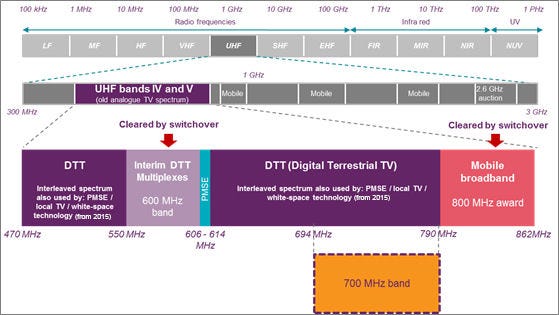Ofcom to free up 700 MHz band for mobile, eventuallyOfcom to free up 700 MHz band for mobile, eventually
UK telecoms regulator Ofcom has announced it will make the 700 MHz frequency band available for mobile broadband services, effectively moving broadcast TV and wireless microphones aside to make room. There’s no need for operators to reform their auction teams just yet though, as Ofcom doesn’t reckon it’s going to happen until 2022.
November 19, 2014

UK telecoms regulator Ofcom has announced it will make the 700 MHz frequency band available for mobile broadband services, effectively moving broadcast TV and wireless microphones aside to make room. There’s no need for operators to reform their auction teams just yet though, as Ofcom doesn’t reckon it’s going to happen until 2022.
Citing a forecast that demand for mobile data will be 45x higher by 2030 than it is today, Ofcom makes the case that operator’s needs exceed those of broadcasters. “This is a crucial next step in the development of the UK’s communications infrastructure,” said Ofcom boss Ed Richards. “This decision ensures that we are making the raw materials available with which investors and companies can build the services which will support the digital economy of the future.”
The formal decision, published today, is the culmination of a consultation that commenced last May. It makes a point of stressing how kicking the Digital Terrestrial TV (DTT) channels off the 700 MHz band won’t cause any problems, while stressing the greater good is best served by giving the 700 MHz band to mobile.
In one of those handy extrapolation exercises Ofcom has calculated that this move will deliver undefined benefits to the UK of around £1 billion, but that the cost of the move will be around £600 million. Ofcom stresses that it’s down to the government to fund these costs, so it’s reasonable to anticipate another spectrum auction in the next few years.
The 700 MHz band would, of course, be very useful to operators, offering as it does superior range and indoor coverage properties, as well as potentially participating in the global APT700 LTE band. Demand for the spectrum is likely to be high and, as you can see from the Ofcom diagram below, there will be around 100 MHz of spectrum on offer. But the broadcast TV industry is likely to lobby for as much compensation for the move as possible and there are a number of other practical and regulatory hurdles to overcome before we’re living the 700 MHz dream.

Step Aside Dtt
About the Author
You May Also Like










.png?width=300&auto=webp&quality=80&disable=upscale)


_1.jpg?width=300&auto=webp&quality=80&disable=upscale)